In a Nutshell:
- A mattress protector that is both waterproof AND 100% natural doesn’t exist.
- That being said, the healthiest mattress protectors are made out of mostly organic cotton, with a thin waterpoof TPU barrier. TPU is a type of polyurethane that is inert, durable, and flexible. Plus, it’s a much better option than PVC or PFAS treated fabric (both of which are commonly used for traditional mattress protectors).
- Even though a bit of synthetic material is required, getting a waterproof mattress protector is still a good idea because it can prevent mold growth, make cleaning up much easier, and protect your mattress investment.
- Our top picks for organic mattress protector brands are Savvy Rest, My Green Mattress, and Naturepedic. (Scroll down for discount codes + a few more options.)
Table of Contents
- Should You Get a Waterproof Mattress Protector?
- FYI: 100% Organic AND Waterproof Mattress Protectors Do Not Exist…
- Reasons Why It’s Okay to NOT Get a 100% Organic Mattress Protector
- Other Materials That Are Commonly Used for Waterproof Mattress Protectors
- The Best Organic & Non-Toxic Mattress Protectors
- What About A Fully-Encased Organic Mattress Protector?
- Even More Non-Toxic Mattress Protector Options (that are not waterproof)
This article contains affiliate links, which means we may earn a commission if you decide to make a purchase.
Should You Get a Waterproof Mattress Protector?
There are basically three “levels” of mattress protection you can get, and you’ll need to decide which one is best for you based on your specific needs:
- Many non-waterproof mattress protectors provide a basic level of protection against standard wear and tear and allow for easier cleaning. It’s much easier to find non-waterproof mattress protectors that are made from 100% natural and organic materials.
- Waterproof protectors have an extra synthetic layer that provides a better barrier against spills and accidents. It’s not possible to get a 100% organic waterproof mattress protector, but that doesn’t mean you shouldn’t get one at all! We’ll get to that more in a minute.
- Lastly, fully-encased mattress protectors provide even more protection against things like bed bugs and allergens by zipping up the entire mattress. Although we have yet to find a 100% organic waterproof mattress protector that wraps all the way around the mattress, we’ve listed the best options below.
It might go without saying, but here are some of the benefits that should be considered when thinking about which type is right for you:
- Protection against spills & stains. (What level of protection do you need? For example, will there be children sleeping in the bed that are more likely to have an accident?)
- Easy-to-clean. All mattress protectors make it easier to keep your mattress clean and allergen-free for a long period of time. Keep in mind that fully-encased protectors are going to be a bit more difficult to put on and take off whenever it’s time to put it through the washing machine.
- Allergy-relief. Again, all types of mattress protectors will provide a certain amount of protection against things like dust mites, pet dander, and mold. Those with more severe allergies and asthma might want to consider a fully-encased and/or waterproof protector in order to get an extra layer of security.
- Bed bug protection. Those who live in senior living facilities or group homes where bed bugs might be more likely may want to consider a fully-encased option as well.
FYI: 100% Organic AND Waterproof Mattress Protectors Do Not Exist…
…but that’s okay! Here’s the deal:
Natural fibers like organic cotton, hemp, linen, and even TENCEL (which is technically a semi-synthetic) really can’t be waterproof. Even some synthetics like polyester can’t be fully waterproof without either:
- an extra synthetic waterproof layer made from something like PU, TPU, or PVC
- and/or chemical treatments (like water-resistant PFAS, which are toxic)
The best options for non-toxic mattress protectors usually use a combination of PU or TPU combined with something like organic cotton.
You might argue, “But Abbie! PU and TPU are synthetic materials! Their petroleum-based, not sustainable, and could be toxic!”
Yep. But I still think they’re a good option for a waterproof mattress protector.
I’ll tell you why in just a minute.
But first, let me give you a quick brief on PU and TPU.
PU and TPU for Waterproof Mattress Protectors
Polyrethane (PU) and thermoplastic polyurethane (TPU) are the most common materials used for the waterproof layer of organic mattress protectors.
PU is more commonly used for “cushion-y” products like furniture foams and shoe insoles. But it can also be used as a waterproof protective layer on top of a variety of things, including backpacks, electrical equipment, and even infrastructure like bridges.
TPU is a type of PU that tends to be even more durable than PU, while still remaining flexible. It’s also more inert than PU, which means it’s much less likely to leach toxic chemicals, even when exposed to heat.
This is why TPU is one of the best materials for a waterproof organic mattress protector: it truly works in protecting against spills and accidents, while being durable, flexible, and resistant to chemical leaching.
So TPU is the best option, with PU coming in second.
(Side note: you may be wondering about polyethelene, which is often considered one of the “safer” kinds of plastic and can be manufactured to be food-grade. While that initially sounds like a good option, polyethene unfortunately is not as durable and can’t hold up as well when put through the washing machine repeatedly. That’s why it’s not used for mattress protectors.)
Reasons Why It’s Okay to NOT Get a 100% Organic Mattress Protector
1. Protection from Mold
One of the main reasons you’re probably considering a waterproof mattress protector (as opposed to an alternative topper that’s not waterproof) is because there are likely to be scenarios where your mattress could get wet. Think about:
- Babies, kids, and elderly folks who are more likely to have accidents in bed.
- If you tend to have a glass of water on your nightstand (like I do) or a cup of coffee in bed in the morning and could have accidental spills.
These spills can lead to mold, mildew, and bacteria growing in your mattress… And once it’s there, it can be very difficult (practically impossible, really) to get rid of the mold spores completely.
A moldy sleeping environment can be problematic for anyone, but especially for those with chronic inflammatory response syndrome (CIRS), multiple chemical sensitivity (MCS), allergies, or asthma. Think about how much time you spend on your mattress and how close your face is to that surface… You do not want to be breathing in all those mold spores all night long!
2. Protection of Your Mattress Investment
Mattresses are expensive! And sometimes (though definitely not always), organic mattresses are even more expensive than conventional ones.
You don’t want to waste your money, and you also don’t want to have to throw another mattress into the landfill.
So getting a waterproof mattress protector is a great way to help make your mattress last as long as possible.
3. PU/TPU is Better Than Toxic PFAS
A mattress protector that’s made out of 95% organic cotton and 5% PU or TPU is almost automatically going to be a better option than something that is made from 100% synthetic materials like polyester or something that’s coated with a PFAS finish.
Like we already talked about, a lot of fabrics cannot be waterproof by themselves. PU, TPU, and PVC are a few of the materials that actually can be waterproof without any added chemicals.
For this reason, waterproof mattress protectors that are made from things like cotton, bamboo, or TENCEL but without a PU/TPU layer are almost guaranteed to have chemical additives.
And what’s the most common chemical treatment used to make things water-resistant? PFAS.
PFAS are the “forever chemicals” that you hear about in the news a lot these days. They’re perhaps most commonly known for their use in non-stick cookware (Teflon), but they’re also used in things like rain jackets, food packaging, and more.
They’re bioaccumulative, which means they don’t break down in the human body or the wider environment (hence the name “forever chemicals”), which is one the reasons why they’ve become such a huge problem. They are linked to a wide range of health concerns, from birth defects to cancer to ulcerative colitis, and more. There is essentially no “safe level”for most PFAS chemicals.
Also consider that PFAS aren’t great at staying on the surface they were added to. Instead, they “flake off” of household goods and land in the dust, where you and your loved ones can then breathe them in or ingest them via hand-to-mouth contact.
(This is different from TPU, which is relatively inert, meaning that it doesn’t easily leach.)
To make matters worse for consumers, there’s nothing that requires companies to tell you whether or not your mattress protector (or any other textile product) has been treated with PFAS. You won’t see it on the label and therefore it’s practically impossible to tell whether or not it’s non-toxic.
So, all of that under consideration, which would you rather have:
- a cotton mattress protector that does not contain TPU but instead is treated with a layer of PFAS on top, which is probably going to wear off into the air/dust in your bedroom over time
- or a mattress protector that is not treated with PFAS but instead has an inert layer of TPU sandwiched between two layers of organic cotton?
I’m going with the second option.
Other Materials That Are Commonly Used for Waterproof Mattress Protectors
Now that we’ve talked about what makes a mattress protector waterproof, let me give you a brief rundown of the other common materials used in mattress protectors on the market so you know what to look out for.
PVC
PVC isn’t as popular as it used to be for mattress protectors, which I would say is a good thing overall. I believe the main reason it’s not used as much anymore is because it tends to be noisier. You know what I’m talking about: those plastic-y mattress protectors that make crinkly sounds when you move.
By now, manufactureres have figured out how to make mattress protectors that are much quieter (so much so that you might not even notice they’re on your bed), but are still equally as waterproof.
That’s a good thing because PVC is one of the most toxic kinds of plastic. Not only is the production process a major source of air pollution, but the end product tends to contain toxicants like phthalates, dioxins, and heavy metals.
Polyester
Many mattress protectors use polyester, especially for the outer and side layers. Polyester is the most widely-used fabrics in the world. It’s also one of the cheapest, which is one reason why home textile brands use it.
When it comes to toxicity, polyester is not as bad as PVC, but it’s not great either. Polyester often contains heavy metals like antimony, endocrine disruptors like BPA, and more. You can check out our deep dive into polyester here.
The other thing to keep in mind is that polyester cannot be 100% waterproof without either some sort of extra chemical treatment (which could involve PFAS) and/or an extra waterproof layer in the middle (which would probably be something like PVC, PU, or TPU).
Bamboo
Bamboo is another fabric you’ll often see for mattress protectors. Bamboo is a fast-growing plant that tends to be a more eco-friendly alternative to polyester (which is a petroleum product) or cotton (which is resource-intensive).
However, bamboo is a material that tends to be greenwashed a lot, too! Bamboo fabric is technically considered a “semi-synthetic.” While it’s made from plant-based materials, it has to be processed so much that by the time it’s been transformed into an end product, it’s no longer truly “natural.”
As you might imagine, there are a lot of chemicals that go into that manufacturing process, and some of them are more toxic than others. If you want to learn more about this, you can do so here.
Just like with a lot of other fabrics, bamboo cannot be waterproof by itself. So you have to consider what might have been added to the bamboo fabric in order to make it waterproof. If you see a product labeled as a “Premium Bamboo Waterproof Mattress Protector,” don’t take it at face value because there are certainly other materials at play in addition to the bamboo.
There seems to be an overall lack of transparency in the whole world of mattress protectors in general, which is something to be aware of. For example, check out this screenshot from a “bamboo” mattress protector on Amazon. It says the top surface is 100% bamboo, but that’s all the info you get. What are the inner, bottom, and side layers made out of? Is it treated with anything? We don’t know!

Cotton
It’s a similar story with cotton. Obviously, cotton is a natural fiber that tends to be healthier, more eco-friendly, and pretty hypoallergenic. But it can’t be waterproof without either a chemical treatment or an added layer of something else, such as PU.
Organic cotton is best because it’s grown without the use of toxic pesticides. But one could artgue that conventional cotton is probably still a better option than a petroleum product like polyester.
As you’ll see, most of the non-toxic mattress protector brands we recommend below use organic cotton for the majority of the item.
The Best Organic & Non-Toxic Mattress Protectors
Alright, now let’s get into more detail about our favorite brands for organic cotton mattress protectors:
1. Savvy Rest

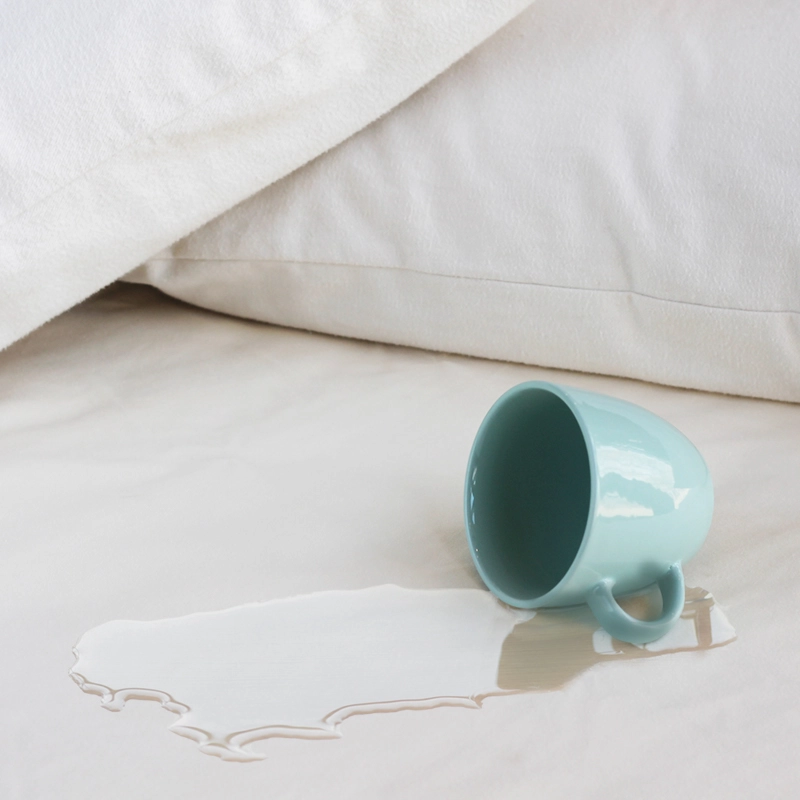
Materials: TPU, Organic Cotton
Waterproof? Yes
Price: $89 (crib) – $159 (CA King)
Pocket size: 15” (and 7″ for the crib size)
Instead of vinyl, Savvy Rest’s Waterproof Mattress Protector utlizes a layer thermoplastic polyurethane (TPU), which is laminated to organic cotton using a solvent-less melted adhesive that becomes inert after it dries and cools. The end result is a waterproof fabric that has a specific thickness and pore size that stops liquids from coming into contact with your mattress while still allowing your mattress to breathe.
Just like the rest of Savvy Rest’s bedding, mattresses, and furniture, these mattress protectors are free from toxins like flame retardants, PFAS, and pesticides.
They also have a few other (non-waterproof) options as well, including a Wool Mattress Pad, a Cotton Mattress Pad, and a Crib Mattress Pad. These pads do help protect from a certain level of moisture, but they’re not fully waterproof. They are mostly for some extra cushion and to provide some more protection against normal wear and tear, helping to extend the overall life of your mattress.
They’re all made in the USA, too!
Use the code THEFILTERY20 for 20% off.
2. My Green Mattress
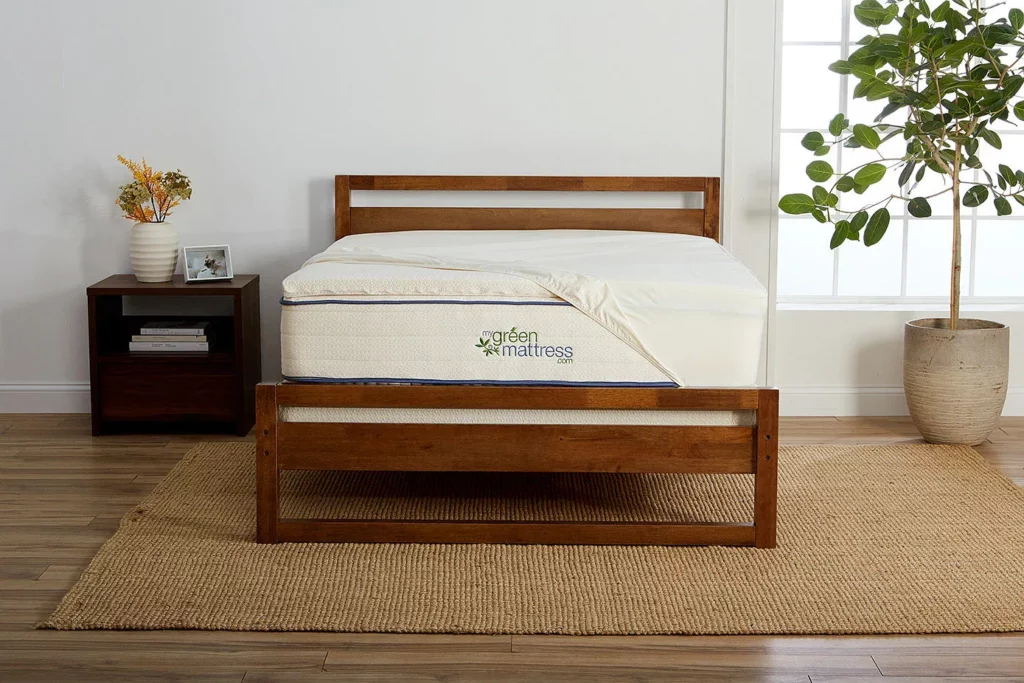
Materials: TPU, Organic Cotton
Waterproof? Yes
Price: $69 (crib) – $159 (CA King)
Pocket size: Fits mattresses up to 14 inches thick or crib mattresses up to 6 inches thick
My Green Mattress’s protector is made out of two layers of GOTS certified organic cotton fabric and a breathable but waterproof TPU barrier in the middle. Instead of petroleum, the TPU is made from made from renewable sources, including non-GMO corn.
It’s GREENGUARD Gold and OEKO-TEX compliant, and free from things like flame retardants, vinyl/PVC, phthalates, or rubber. It’s also sewn by hand in their factory in LaGrange, IL.
My Green Mattress also carries a plush organic latex topper as well as lots of other organic bedding essentials, like mattresses, bed frames, pillows, sheets, and more.
(If you get a mattress, you can use the code THEFILTERY20 to get the most current best price.)
3. Naturepedic / Happsy
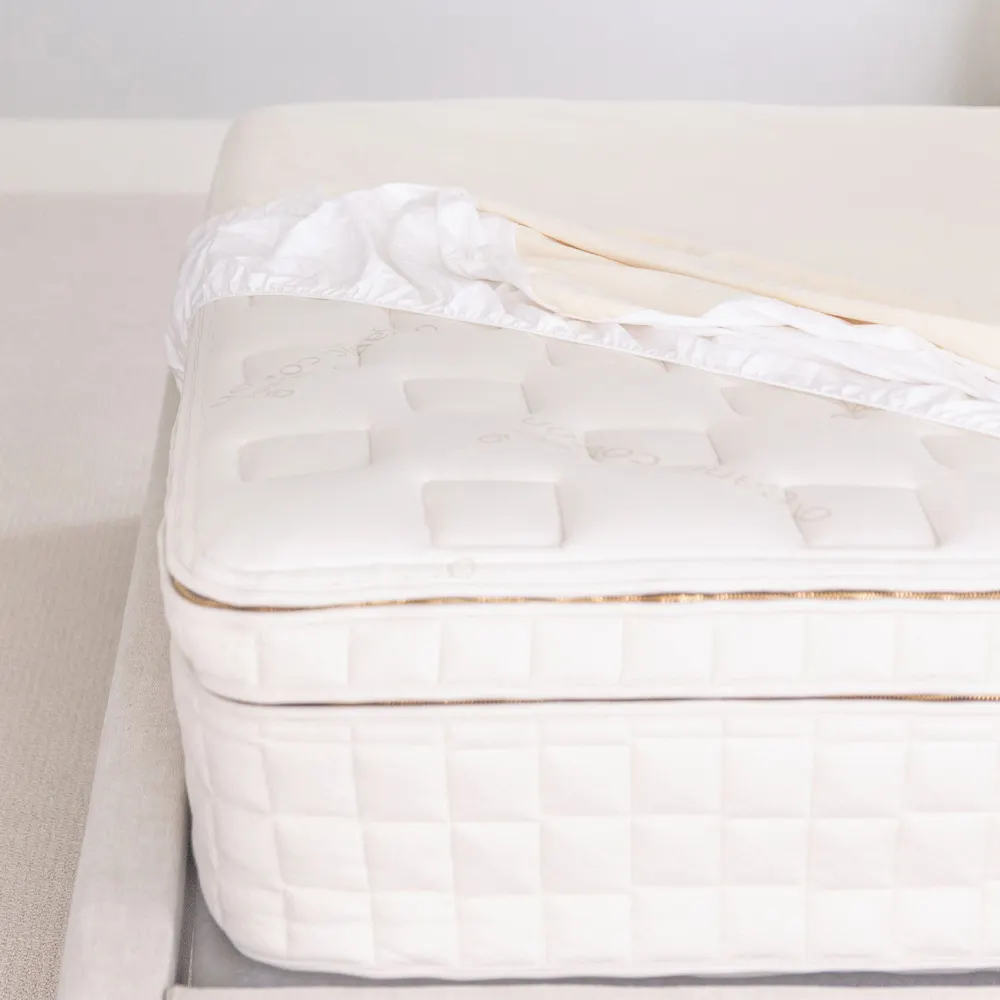

Materials: TPU, Organic Cotton
Waterproof? Yes
Price: $79 (Happsy Twin) – $179 (Naturepedic CA King)
Pocket size: 9″ to 16″
Naturepedic and Happsy are actually owned by the same company, so their mattress protectors are basically the same. (Happsy is the more affordable sub-brand of Naturepedic.)
Like the two brands above, Naturepedic and Happsy use a thin layer of waterproof TPU, which is sandwiched in between two laters of 100% Global Organic Textile Standard (GOTS) organic cotton. It also has tiny pores that allow water vapor to pass through it in order to reduce sweat and humidity.
The Naturepedic version comes with more certifications, such as MADE SAFE and GREENGUARD Gold, as well as 1% For the Planet. It also comes with more risk-free features such as free shipping and returns, a 30-day money-back guarantee, and a limited 1-year warranty. (Not providing these ‘extras’ for the Happsy mattress protector is probably one of the ways they’re able to offer it at a more affordable price point.)
In addition to their mattresses, Naturepedic and Happsy both carry other bedding accessories as well. Naturepedic has an organic waterproof mattress protector for kids’ mattresses and cribs, as well as other toppers, pillows, and more.
Use code thefiltery15 for 15% off.
If you buy a mattress from Happsy, you can use the code thefiltery225 for $225 any size mattress. However, that code will not work for a mattress protector.)
4. Nolah
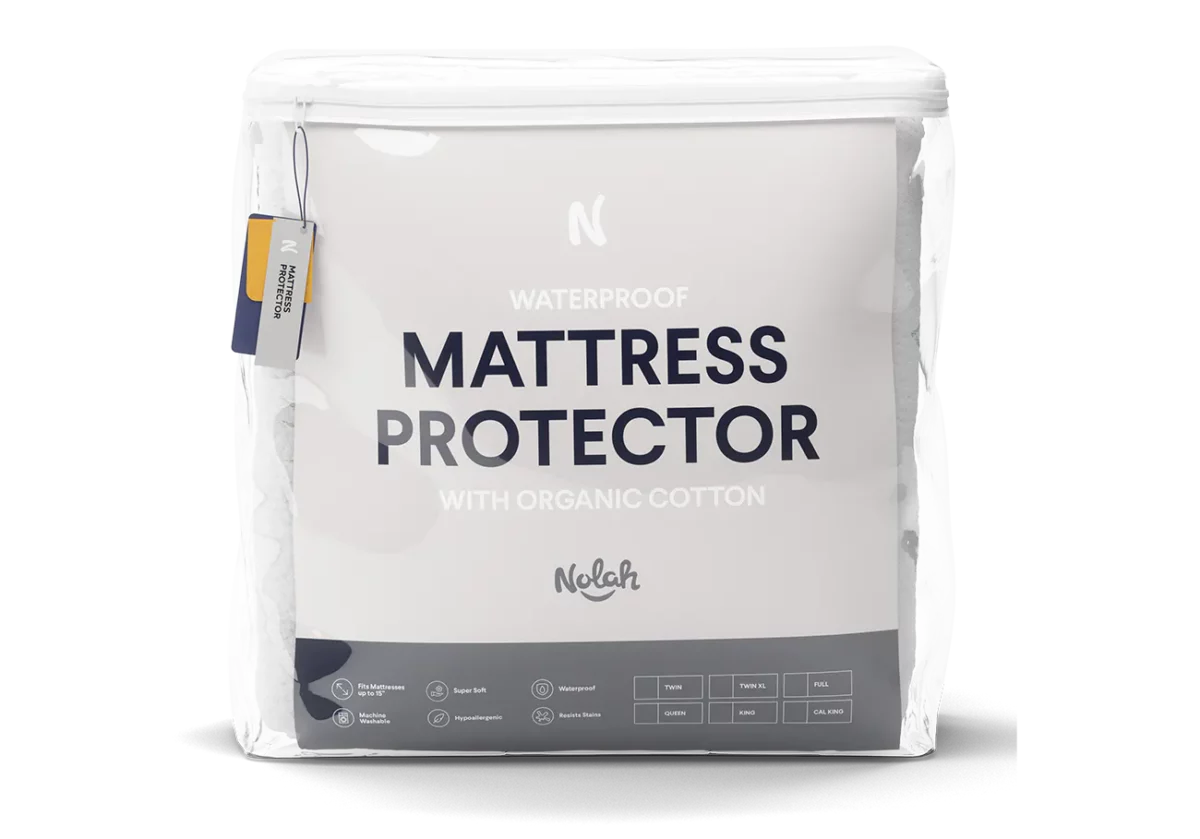
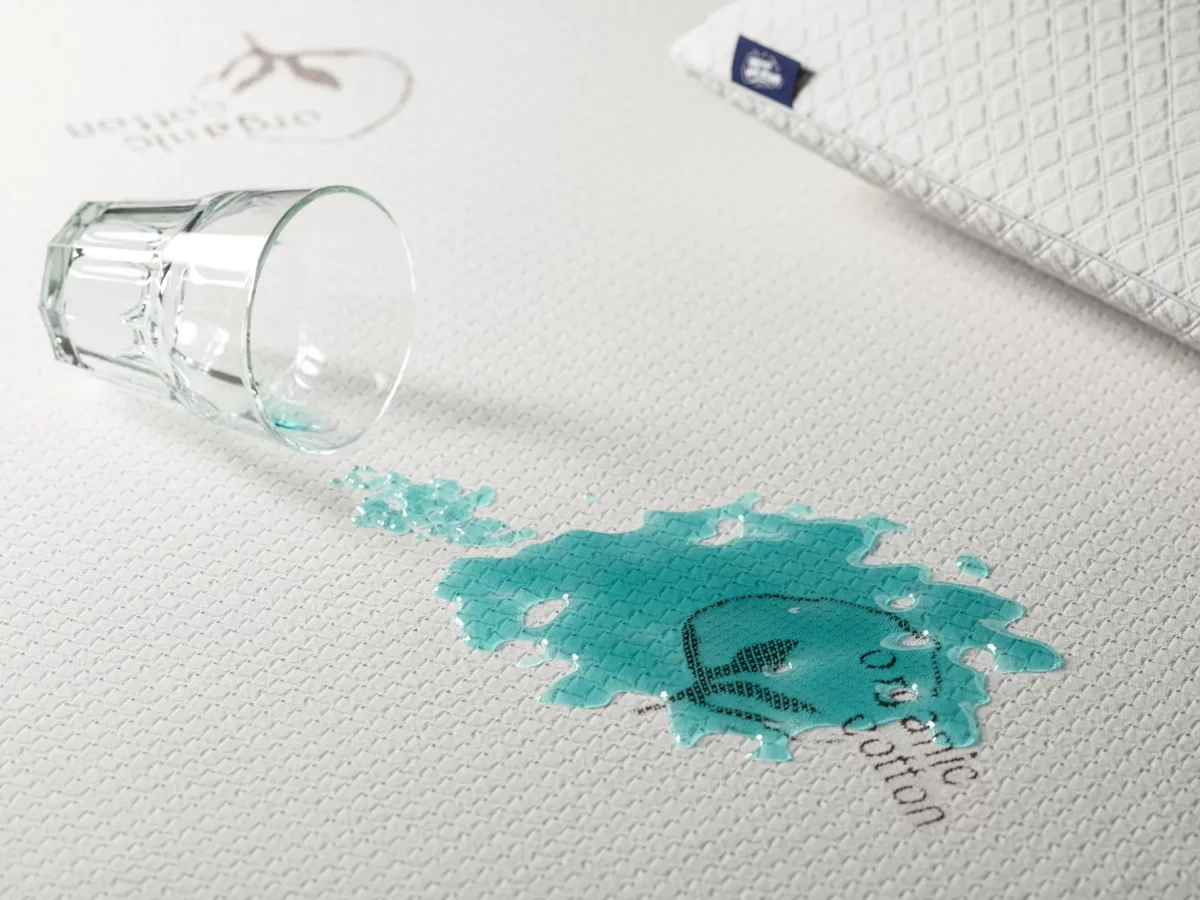
Materials: TPU, Organic Cotton
Waterproof? Yes
Price: $99 (Twin) – $129 (CA King)
Pocket size: 15″
Nolah is one of the best options for an affordable non-toxic waterproof mattress protector!
The inner waterproof layer is made out of TPU, which is sandwiched by two layers of organic cotton on either side. While the organic cotton itself does not come with a third-party certification, the mattress protector as a whole is OEKO-TEX Standard 100 certified.
It also comes with a 10-year warranty!
5. Birch

Materials: PU, Organic Cotton
Waterproof? Yes
Price: $89 (twin) – $129 (CA King)
Pocket size: 16″
Birch also has an organic waterproof mattress protector that comes in at a pretty affordable price.
It comes with GOTS organic and Fair Trade Certifications, as well as several other consumer perks—like free shipping, a 100-night sleep trial, and a 1-year warranty.
It’s made with two layers of organic jersey-knit cotton that comes in a natural, undyed cotton color. Between those two cotton layers is a layer of PU, which makes it fully waterproof while still being soft (no crinkling!).
6. PlushBeds

Materials: PU, Organic Cotton
Waterproof? Yes
Price: $136 – $288 (CA Split King)
Pocket size: 15″
The main differentiator between the mattress protectors above and this one from PlushBeds is the sizing options available. PlushBeds offers your standard bed sizes, but they also have options for a split queen, split king, and sofa beds (twin, full, and queen).
They’re made out of GOTS and USDA certified organic cotton plus a thin layer of PU to make them waterproof. It also comes with a 5-year warranty!
PlushBeds also carries other protectors, including a cotton & wool one (which is waterproof but not organic), and other natural wool, latex, and down toppers. Some of their products are natural/organic, while others aren’t—so just make sure to check the details before buying.
What About A Fully-Encased Organic Mattress Protector?
The mattress protectors featured above are 5-sided, which means they cover the top of the mattress and then wrap around the sides, the way a standard fitted sheet does.
Some mattress protectors are 6-sided, or “fully-encased,” which means they also cover the bottom of the mattress and zip up so that the entire mattress is covered.
Although fully-encased mattress protectors are more difficult to put off and on the bed, they’re believed to be an even more powerful protection against things like bed bugs, dust mites, and allergens.
I wasn’t able to find a mattress protector that was both organic/non-toxic and full-encased, but a huge thanks to reader Jacquie, who was able to find one from Sleep & Beyond!
Sleep & Beyond
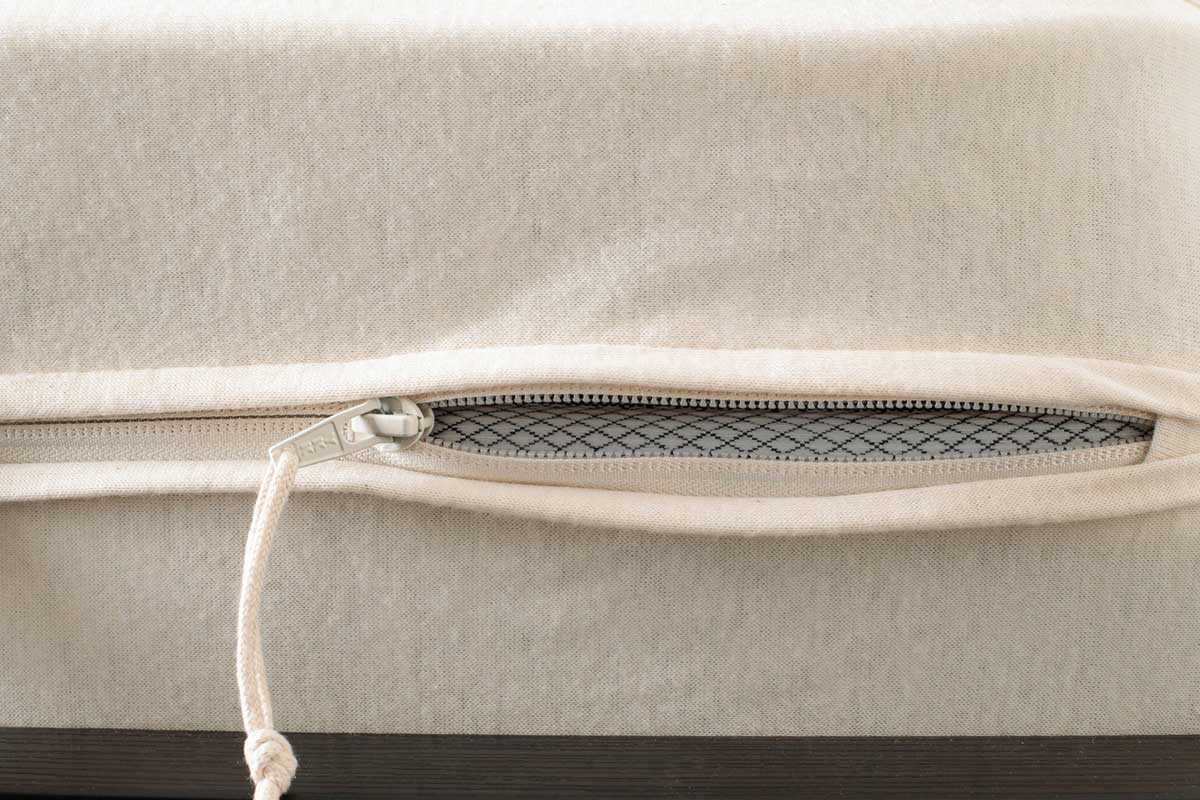
Materials: TPU, Organic Cotton
Waterproof? Yes
Price: $109 (crib) to $438 (CA Split King, 14-inch)
Depth: 6-inch (crib) to 10- or 14-inch (adult beds)
This organic waterproof encased mattress protector comes in just about every size you could possibly need, from crib to California split king.
It’s made primarily out of GOTS certified organic cotton, with a layer of TPU to make it waterproof. The TPU is bio-based and comes with OEKO-TEX, GOTS, and GREENGUARD Gold certifications.
It zips closed to give you 360 degrees of protection for everything from spills and accidents to bed bugs, pet hair, dander, and other allergens.
Here are some other 6-sided mattress protectors that aren’t the best but are still “okay”:
- Goodnight Naturals allergy mattress encasement (certified organic cotton without added chemicals, but not waterproof)
- AllergyCare™ Organic Cotton Mattress Encasing (organic cotton without added chemicals, but not waterproof)
- Company Cotton™ Waterproof Mattress/Box Spring Protector (This one IS waterproof and is made out of natural cotton—not organic—but it’s unclear what the waterproof layer is actually made out of. We’ve reached out to The Company Store to ask and will update this if/when they answer us. The Company Store also carries an organic cotton version that’s not waterproof.)
- Nest (It is waterproof using TPU, but it’s not organic. The top is made out of 100% conventional cotton and the sides are made out of 92% polyester and 8% spandex.)
Even More Non-Toxic Mattress Protector Options (that are not waterproof)
If you want a mattress protector but don’t necessarily need something that’s waterproof, then it’s much easier to find an option that is 100% organic and free from all synthetic materials. Most of the brands above offer several different options for you, but here are some additional brands that offer organic mattress protectors, pads, and toppers:
RELATED ARTICLES:
- The Best Organic & Non-Toxic Mattresses
- Where to Find Non-Toxic Bedding
- Natural & Organic Duvets & Comforters
I hope this guide has helped you find the best organic waterproof mattress protector for you! To get exclusive content, news, tips & tricks, and more delivered to your inbox once a week, be sure to sign up for Filtered Fridays.






This helped me decide which mattresses to buy for my family! Thank you! Do you think a pillow protector needs to be waterproof as well? I figure since your head is laying on it, it might be more important for it to be free of potentially toxic/unnatural materials…?
Hi there,
It’s not a bad idea! I would say that if you sweat a lot or sleep with wet hair or something like that then it would make more sense to get a waterproof pillow protector. 🙂
Abbie, you’re amazing. I’ve spent a few hours researching this and you answered all my questions- things make sense now. I found the mattress cover from Nolah to be the best by far price wise. There are no red flags to me. They have organic cotton & bamboo. I’d love to hear if you approve of those two. It’s a great Black Friday deal that I want to purchase but hope it’s safe. Thanks!!
Thanks, Jess! Good call on Nolah. I would recommend the organic cotton one. It doesn’t say what EXACTLY the waterproof poly layer is made out of, but I’ve emailed them to ask.
Hello Abbie,
I have been searching for days trying to find a fully encased organic mattres protector for our king Naturepedic mattress, along with another one for our daughter’s new queen. While I’m happy your reader found one from Sleep and Beyond which I will be ordering for our daughter, unfortunately they cap out at 15 inches and our mattress is 16. We currently have the naturepedic waterproof wool protector bit it is not encased. Would you suggest purchasing an organic fully encased protector then adding the waterproof wool protector on top? If so, will you recommend a fully encased organic one?
I’m so glad I found your site! I’ve always wanted a weighted blanket but never bought one because of the toxins. Now that I’ve seen your recommendation for the Bearaby, I know what’s on my Christmas list! Thank you!
Hi Jamie,
Glad you found the site, too! 🙂 Yes, I love my Bearaby – I use it pretty much every evening. It will be a great Christmas gift!
For the mattress protector: Unfortunately, I don’t think I’ve been able to find one that is fully-encased, full-organic, AND 16+ inches in depth… I will definitely keep my eye out, though! I’m sure someone will make one eventually… In the meantime, I would probably say to just go with the waterproof one that’s not fully-encased. It should serve your purpose by keeping your mattress dry, etc… IF anyone in your family has severe allergies or if you are worried about bed bugs or something like that, those would be reasons I would say to go with the fully-encased one…in which case, I would suggest going with one of the not-fully-organic ones from one of the other brands listed here (which offer options 16+ inches in depth).
Hi! https://www.mollymutt.com/couch-cover-kit/ says its couch cover is PFAS-free, but there’s no indication on the material used to make it waterproof. Do you think it being PFAS-free is sufficient enough?
Hey Phil! I actually reached out to Molly Mutt to get more clarification on this and they said the cover actually isn’t treated at all. So while it will probably provide some protection for sure, it’s not *technically* water- or stain-resistant.
https://www.keetsa.com/collections/protectors/products/mattress-protector?variant=243410316 May be an enclosed mattress protector that is all natural. But they do not list the materials on their site. But another review site says they are. Waiting for a reply from the company.
Hi Andrea, thank you for that! I will reach out to them as well. Definitely not a great sign that they don’t list the materials on the page. I would guess that since it’s advertised as “anti-mite,” it’s probably treated with antimicrobials…